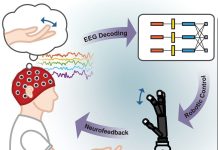
Researchers at Uppsala University and Karolinska Institutet have made a breakthrough that could allow robots and prosthetic hands to feel touch just like human hands.
Their study, published in the journal Science, may also help restore lost functions to stroke patients.
“Our system can quickly identify objects by touch, much like a blindfolded person can tell the difference between a tennis ball and an apple,” says Zhibin Zhang from Uppsala University’s Department of Electrical Engineering.
Zhang and his colleague, Libo Chen, worked closely with experts in data processing and machine learning from Uppsala University and neurogeriatrics researchers from Karolinska Institutet.
Inspired by neuroscience, they created an artificial touch system that mimics how the human nervous system responds to touch.
This system uses electrical pulses to process touch information, similar to how our nerves work.
“With this technology, a prosthetic hand could feel like a natural part of the user’s body,” Zhang explains.
The system includes three main parts:
- Electronic Skin (e-skin): This skin has sensors that detect pressure.
- Artificial Neurons: These neurons convert touch signals into electrical pulses.
- Processor: This processes the signals to identify objects.
In tests, the system successfully identified 22 different objects and 16 surfaces by touch. The researchers believe it can learn to recognize many more.
“We are also exploring how to make the system feel pain and heat. It should also be able to tell what material it is touching, like wood or metal,” says Libo Chen, who led the study.
The researchers say this touch feedback can make interactions between humans and robots, or prosthetic hands, safer and more natural. It would also give prosthetic hands the ability to handle objects as skillfully as human hands.
“Human skin has millions of touch receptors. Current e-skin technology can’t match that, but our technology brings us closer. We aim to create artificial skin for entire robots,” says Chen.
This technology has medical uses too. It could monitor movement problems caused by Parkinson’s or Alzheimer’s disease and help stroke patients regain lost functions.
“The system could even detect if a patient is about to fall and then stimulate muscles or activate assistive devices to prevent the fall,” Zhang adds.
This new touch technology marks a significant step forward in robotics and prosthetics, promising a future where artificial hands can feel and function just like real ones.
Source: Uppsala University.



